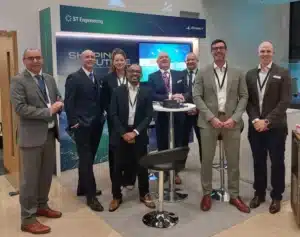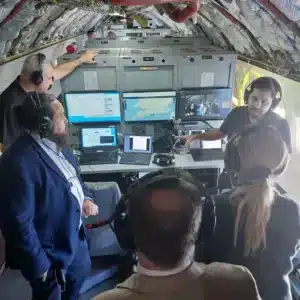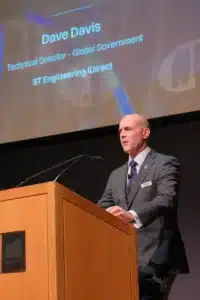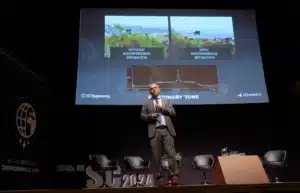
The standout themes this year were those that have been reverberating around the milsatcom industry over the past couple of years and they were: the resilience of networks; multi-orbit capability; increase of space-based threats, Positioning, Navigation and Timing (PNT) denial, interference. Interestingly, another trend that was obvious was the demographic of the delegates with many younger participants and a good proportion under the age of 40. There is a new, young crowd emerging – and it was refreshing to see! The ST Engineering iDirect team were on site, participating in presentation sessions, customer and partner meetings, and some pretty exciting inflight demonstrations with our Honeywell partners – read on to learn more.
Honeywell P.A.C.E. Demos
There is nothing like seeing technology in action to appreciate what it brings to the table. Dave Davis, Senior Technical Director, and Michael Lawrence, Senior Systems Engineer, got to experience it firsthand as they participated in Honeywell’s resilient airborne beyond-visual-line-of-sight (BVLOS) communications demo.
The Boeing 757-200 test aircraft is fitted with Honeywell’s JetWave MCX Ka-band satellite communication (satcom) system as well as an L-band Airborne Intelligence, Surveillance and Reconnaissance (LAISR) solution and an L-band Iridium satcom capability. It features primary-alternate-contingency-emergency (PACE) connectivity solutions including Viasat’s GX network, powered by an iDirect CX780 modem.

The demonstration cemented that PACE can be employed successfully, even at 30,000 feet. The user experience was in no way impacted by the switching of access technologies. Users were able to test their own applications as it was not a controlled demo environment. WhatsApp calling was seamless whilst switching connectivity during the demonstration and banking was used to demonstrate the antenna performance. This is a technological nirvana as it is what the telco and satellite industries have been working together to achieve. It is proof that the technology is available today to knit both terrestrial and satellite connectivity together, seamlessly, thus achieving highly resilient communications for the defense sector.
 Ensuring Operational Integrity – Keynote Takeaways
Ensuring Operational Integrity – Keynote Takeaways
Koen Willems, our VP EU/NATO Programs and Government Relations, delivered a keynote on ‘Ensuring Operational Integrity: Mitigating Interferences in MilSatcom’. His presentation discussed the importance of taking a multi-layered security and resiliency approach to mitigate interferences whether intentional or unintentional.
The nature of warfare is changing, and we are moving from a situation where we previously encountered asymmetric warfare (such as amateur attempts to jam signals with improvised technology) towards symmetric capabilities, where highly sophisticated systems are attempting to listen into or take out our communications.
By employing multi-layered security and resiliency, which is the orchestration of different security technologies working together to make sure that the end-user has continuous traffic without interruptions, we reduce the risk of interception.
Keeping Interference at Bay – Key Technologies
Interference continues to be an ongoing problem for defense forces around the world. Signal interference can be very harmful and military operations can be jeopardized by bad actors. There are several technologies that can mitigate the impact of interference on government and defense networks. Transmission Security, known as TRANSEC, has already proven its worth in conflict zones. It prevents an adversary from exploiting information available in a communications channel without necessarily having defeated encryption. TRANSEC is a staple across ST Engineering iDirect’s Evolution Defense platform.
Together with TRANSEC, Communication Signal Interference Removal (CSIR) is a real-time technology that helps to isolate and remove interferers from communication signals.

Flexible and Secure
Dave Davis, also participated on the panel session: ‘Threats and Vulnerabilities; Technical Strengths, Human Weaknesses’. Key discussion points included the requirement for a system to be simple to use and manage, automation should be introduced where possible to reduce the potential for human error, and in a world of increasing collaboration, the system should remain flexible whilst maintaining security boundaries.
Learn more about ST Engineering iDirect’s Resilient Integrated Solutions for Milsatcom.

 Ensuring Operational Integrity – Keynote Takeaways
Ensuring Operational Integrity – Keynote Takeaways